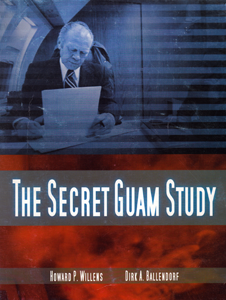Book: Secret Guam Study

In the 1960s the United Nations issued Resolution 1514 (XV) “Declaration on the Granting of Independence to Colonial Countries and Peoples,” as a call to end colonization around the world. As a result, many nations began the process of decolonization as territories negotiated new political statuses and exercised their rights of sovereignty and self-government.
Pacific island territories, including Guam, followed suit and began to visualize what a change in political status could mean for the region and its people. In the 1980s and 1990s, Guam attempted to obtain commonwealth status with the United States, but was unsuccessful in getting the Guam Commonwealth Act approved by the US Congress. Unknown to Guam leaders at the time, however, the federal government was considering granting commonwealth status to Guam as far back as the 1970s.
Federal study recommends Commonwealth Status for Guam in 1975
A United States federal inter-agency task force carried out a study in 1973-74 to look at Guam’s political status at the same time the US was negotiating commonwealth status with the Northern Mariana Islands. Known as the “Guam study,” in 1975 the task force recommended that Guam become a US Commonwealth as well. Their recommendations, however, were shelved without the people of Guam knowing about it until 30 years later.
The Northern Mariana Islands (NMI), along with Palau, Yap, Kosrae, Chuuk, Pohnpei and the Marshall Islands, had been a part of the Trust Territory of the Pacific Islands (TTPI) created by the United Nations and administered by the US since 1947. In the early 1970s each of the island groups negotiated with the US to achieve a more permanent political status. The Northern Marianas chose to be a US Commonwealth.
The federal governmental agencies administering Guam knew that there was growing dissatisfaction on Guam with its territorial status position. People on Guam held mixed views as to what the island’s political status should be and on reunification with the NMI. The islands were politically separated in 1899 when Guam became a US territory and the northern islands of Rota, Tinian and Saipan were bought by Germany. After World War I, the northern islands became territories of Japan until they were overtaken by the US toward the end of World War II. Guam, on the other hand, was under US rule except for two and a half years during World War II when the island was occupied by Japan.
Reunification of the Mariana Islands was put forth in a 1969 referendum, which was accepted by the NMI but rejected by Guam, partly because of the role individuals from the NMI had played in facilitating the Japanese occupation of Guam during World War II and other more complicated economic, political and social considerations. The leaders of Guam also mistakenly believed that Guam would have to fund infrastructure improvements in the NMI and did not believe they could afford to do so.
After reunification failed, the 196-page federal study concluded that some status change would have to occur in Guam. The Guam study determined that commonwealth status would be best for the island, reflecting the fact the NMI was negotiating the same status. Commonwealth status appeared to meet the varying positions of Guamanians and the federal government, particularly the defense needs of the US, according to the report.
Secretary of State Henry Kissinger sent the report to President Gerald Ford. After Ford had reviewed it, Kissinger, in a memo with the report, said that the President agreed with the recommendations and instructed an Under Secretaries Committee to:
seek agreement with Guamanian representatives on a commonwealth arrangement no less favorable than that which we are negotiating with the Northern Marianas. If, however, Guamanian representatives prefer a modified unincorporated territorial status, we will be willing to accept such an arrangement.
Kissinger’s memorandum instructed the Under Secretaries Committee to implement the polices set forth in order to give effect to these objectives:
- Retain US sovereignty over Guam, and, in particular, to maintain US control over Guam’s foreign affairs and defense and preserve US military basing rights to Guam.
- Enable Guam to move toward complete self-government in internal affairs under a self-drafted constitution consistent with the US Constitution in order to enhance prospects for Guam’s continued close relationship with the federal government, and for long-term stability of the island.
- Help promote the material well-being of Guamanians in order to maintain stability on Guam.
- Enhance the prospects for the ultimate integration of Guam with the Northern Marianas if this accorded with the desires of the majority of Guamanians.
The directive specified that:
the Assistant Secretary of Interior for Program Developments and Budget should develop and implement a negotiating approach that will give effect to the above instructions, and should organize a US negotiating team that will include representation from the Departments of State and Defense as well as the Department of Interior.
The directive also ordered that Congress be kept informed of significant developments in the negotiations with Guamanian representatives.
Thwarted by Interior
President Ford left office in 1977 and was replaced by President Jimmy Carter. While the study ordered the Department of Interior to notify Guam’s elected leaders of the newly established policy, Interior officials decided not to do so. Eventually the study was shelved without the people of Guam ever knowing it existed until 30 years later.
This federal study and its outcome are the subject of a book entitled, The Secret Guam Study, by Howard P. Willens and Dirk A. Ballendorf, printed by the Richard Flores Taitano Micronesian Area Research Center, University of Guam and the Northern Mariana Islands Division of Historic Preservation, Saipan in 2004. The memorandum by Kissinger and all the supporting documents are included in the book as appendices.